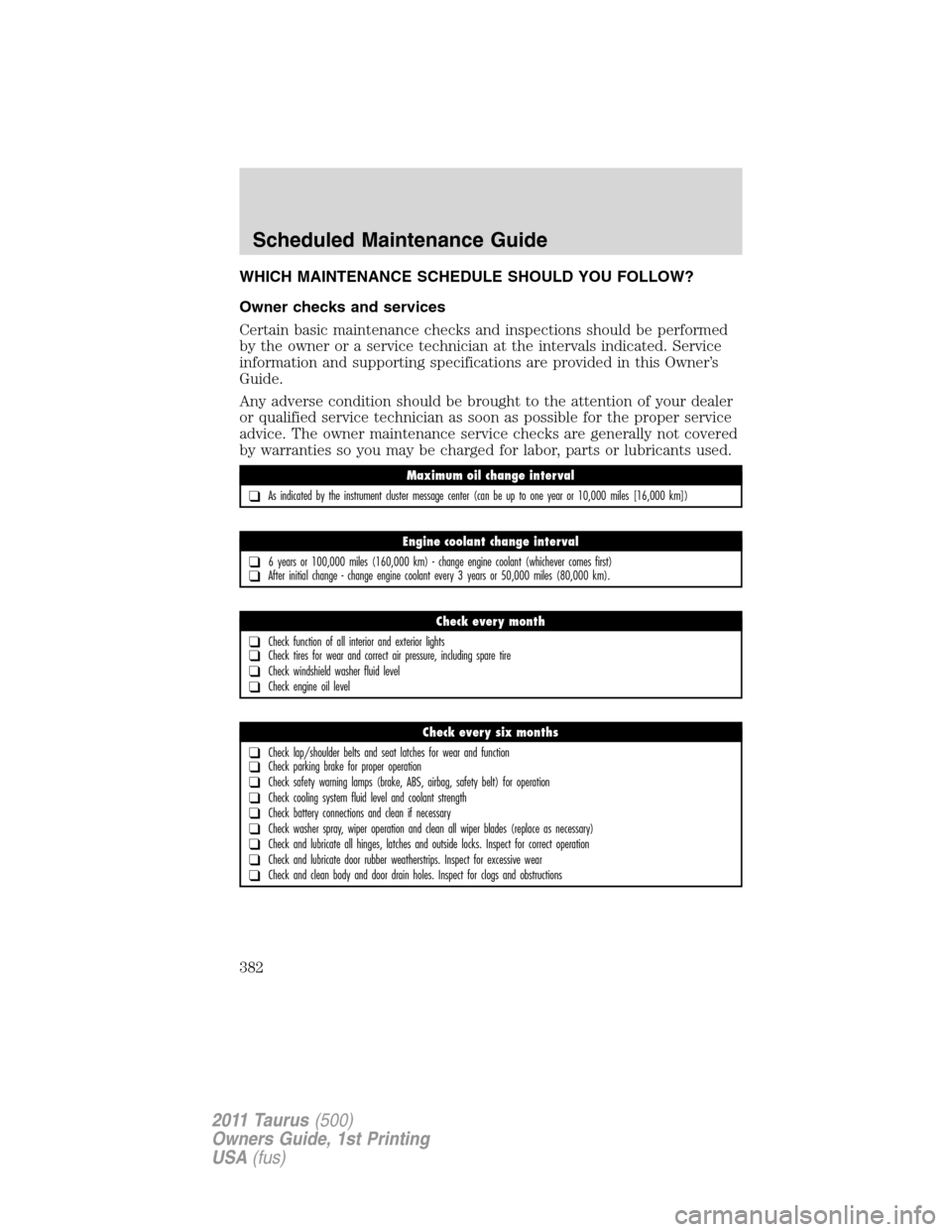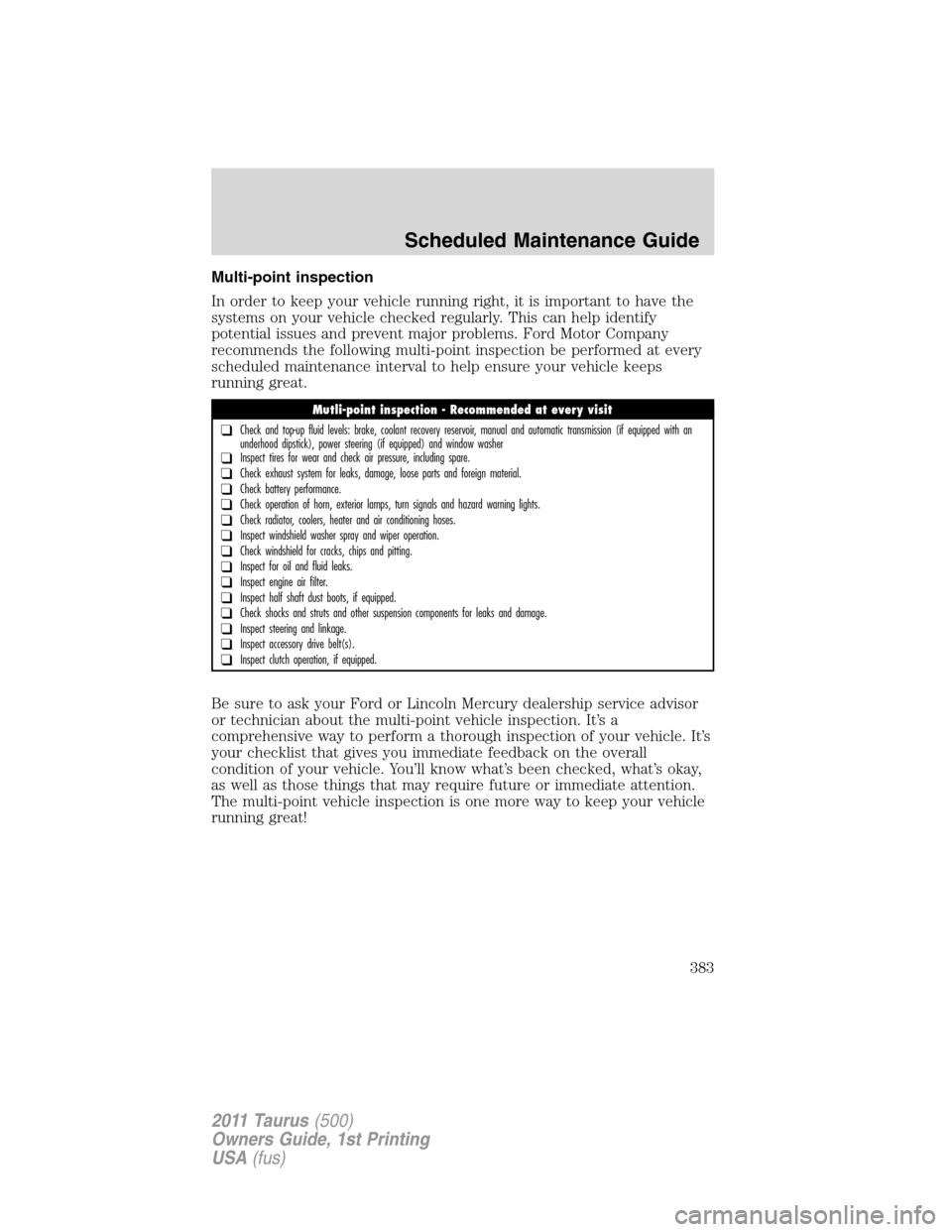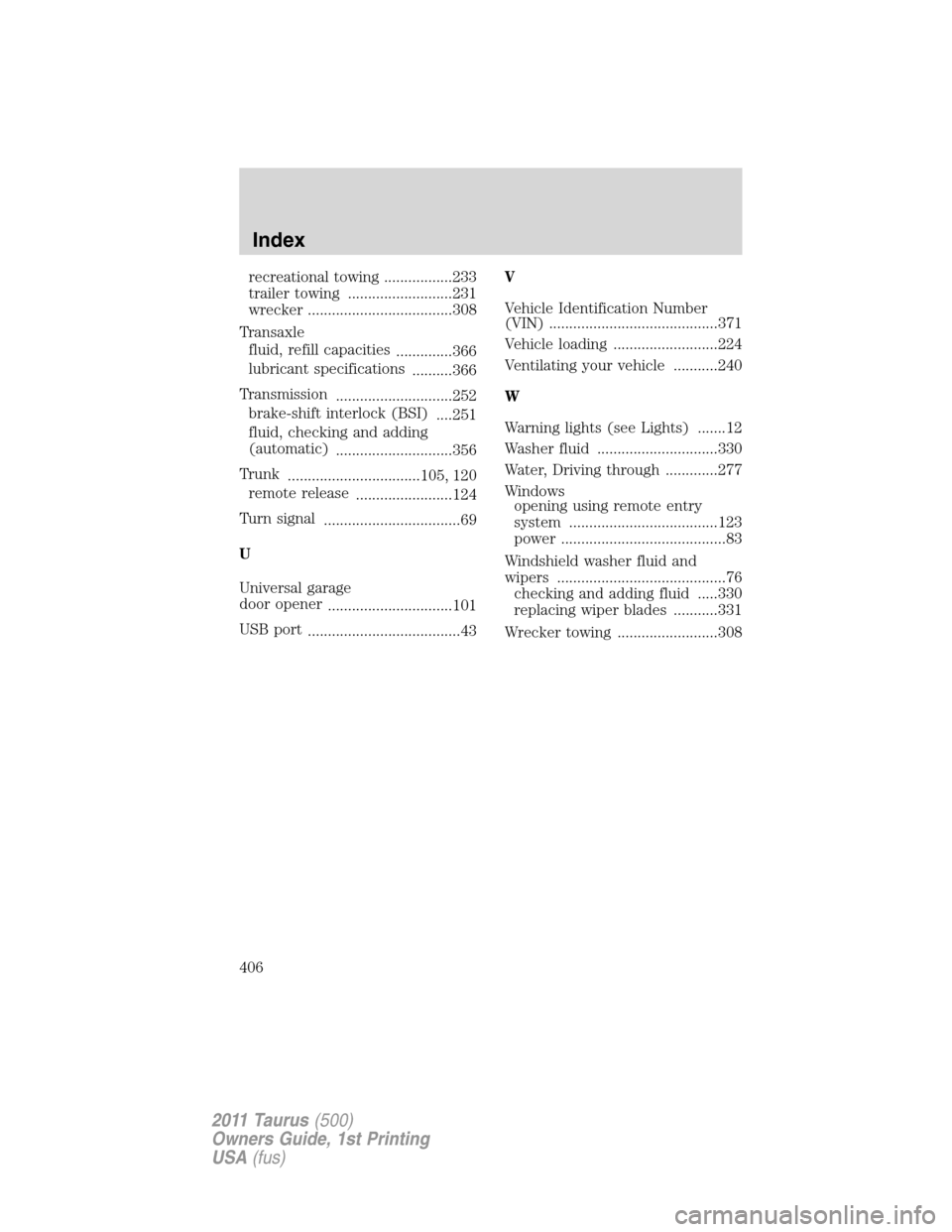2011 FORD TAURUS warning lights
[x] Cancel search: warning lightsPage 242 of 406

•Be sure that areas where the vehicle is parked are clean and clear of
all combustibles such as petroleum products, dust, rags, paper and
similar items.
•Be sure that the engine block heater, heater cord and extension cord
are solidly connected. A poor connection can cause the cord to
become very hot and may result in an electrical shock or fire. Be sure
to check for heat anywhere in the electrical hookup once the system
has been operating for approximately a half hour.
•Finally, have the engine block heater system checked during your fall
tune-up to be sure it’s in good working order.
How to use the engine block heater
Ensure the receptacle terminals are clean and dry prior to use. To clean
them, use a dry cloth.
Depending on the type of factory installed equipment, your engine block
heater will use .4 to 1.0 kilowatt-hours of energy per hour of use. Your
factory installed block heater system does not have a thermostat;
however, maximum temperature is attained after approximately three
hours of operation. Block heater operation longer than three hours will
not improve system performance and will unnecessarily use additional
electricity.
Make sure system is unplugged and properly stowed before driving the
vehicle. While not in use, make sure the protective cover seals the
prongs of the engine block heater cord plug.
BRAKES
Occasional brake noise is normal. If a metal-to-metal, continuous grinding
or continuous squeal sound is present, the brake linings may be worn-out
and should be inspected by an authorized dealer. If the vehicle has
continuous vibration or shudder in the steering wheel while braking, the
vehicle should be inspected by an authorized dealer.
Refer toWarning lights and
chimesin theInstrument Cluster
chapter for information on the brake
system warning light.
P!
BRAKE
Driving
242
2011 Taurus(500)
Owners Guide, 1st Printing
USA(fus)
Page 348 of 406

could cause damage to the fuel system. Repairs to correct the effects of
using an aftermarket product in your fuel may not be covered by your
warranty.
Many of the world’s automakers approved the World-Wide Fuel Charter
that recommends gasoline specifications to provide improved
performance and emission control system protection for your vehicle.
Gasolines that meet the World-Wide Fuel Charter should be used when
available. Ask your fuel supplier about gasolines that meet the
World-Wide Fuel Charter.
Cleaner air
Ford endorses the use of reformulated “cleaner-burning” gasolines to
improve air quality, per the recommendations in theChoosing the right
fuelsection.
Running out of fuel
Avoid running out of fuel because this situation may have an adverse
effect on powertrain components.
If you have run out of fuel:
•You may need to cycle the ignition from off to on several times after
refueling to allow the fuel system to pump the fuel from the tank to
the engine. On restarting, cranking time will take a few seconds longer
than normal. With keyless ignition, just start the engine. Crank time
will be longer than usual.
•Normally, adding 1 gallon (3.8L) of fuel is enough to restart the
engine. If the vehicle is out of fuel and on a steep grade, more than
1 gallon (3.8L) may be required.
•The service engine soon
indicator may come on. For more
information on the service engine soon indicator, refer toWarning
lights and chimesin theInstrument Clusterchapter.
Refilling with a portable fuel container
With the Easy Fuel™ “no cap” fuel system, use the following directions
when filling from a portable fuel container:
WARNING:Do not insert the nozzle of portable fuel containers
or aftermarket funnels into the Easy Fuel™ system. This could
damage the fuel system and its seal, and may cause fuel to run onto
the ground instead of filling the tank, which could result in serious
personal injury.
Maintenance and Specifications
348
2011 Taurus(500)
Owners Guide, 1st Printing
USA(fus)
Page 382 of 406

WHICH MAINTENANCE SCHEDULE SHOULD YOU FOLLOW?
Owner checks and services
Certain basic maintenance checks and inspections should be performed
by the owner or a service technician at the intervals indicated. Service
information and supporting specifications are provided in this Owner’s
Guide.
Any adverse condition should be brought to the attention of your dealer
or qualified service technician as soon as possible for the proper service
advice. The owner maintenance service checks are generally not covered
by warranties so you may be charged for labor, parts or lubricants used.
Maximum oil change interval
❑As indicated by the instrument cluster message center (can be up to one year or 10,000 miles [16,000 km])
Engine coolant change interval
❑6 years or 100,000 miles (160,000 km) - change engine coolant (whichever comes first)❑After initial change - change engine coolant every 3 years or 50,000 miles (80,000 km).
Check every month
❑Check function of all interior and exterior lights❑Check tires for wear and correct air pressure, including spare tire
❑Check windshield washer fluid level
❑Check engine oil level
Check every six months
❑Check lap/shoulder belts and seat latches for wear and function❑Check parking brake for proper operation
❑Check safety warning lamps (brake, ABS, airbag, safety belt) for operation
❑Check cooling system fluid level and coolant strength
❑Check battery connections and clean if necessary
❑Check washer spray, wiper operation and clean all wiper blades (replace as necessary)
❑Check and lubricate all hinges, latches and outside locks. Inspect for correct operation
❑Check and lubricate door rubber weatherstrips. Inspect for excessive wear
❑Check and clean body and door drain holes. Inspect for clogs and obstructions
Scheduled Maintenance Guide
382
2011 Taurus(500)
Owners Guide, 1st Printing
USA(fus)
Page 383 of 406

Multi-point inspection
In order to keep your vehicle running right, it is important to have the
systems on your vehicle checked regularly. This can help identify
potential issues and prevent major problems. Ford Motor Company
recommends the following multi-point inspection be performed at every
scheduled maintenance interval to help ensure your vehicle keeps
running great.
Be sure to ask your Ford or Lincoln Mercury dealership service advisor
or technician about the multi-point vehicle inspection. It’s a
comprehensive way to perform a thorough inspection of your vehicle. It’s
your checklist that gives you immediate feedback on the overall
condition of your vehicle. You’ll know what’s been checked, what’s okay,
as well as those things that may require future or immediate attention.
The multi-point vehicle inspection is one more way to keep your vehicle
running great!
Mutli-point inspection - Recommended at every visit
❑Check and top-up fluid levels: brake, coolant recovery reservoir, manual and automatic transmission (if equipped with an
underhood dipstick), power steering (if equipped) and window washer
❑Inspect tires for wear and check air pressure, including spare.
❑Check exhaust system for leaks, damage, loose parts and foreign material.
❑Check battery performance.
❑Check operation of horn, exterior lamps, turn signals and hazard warning lights.
❑Check radiator, coolers, heater and air conditioning hoses.
❑Inspect windshield washer spray and wiper operation.
❑Check windshield for cracks, chips and pitting.
❑Inspect for oil and fluid leaks.
❑Inspect engine air filter.
❑Inspect half shaft dust boots, if equipped.
❑Check shocks and struts and other suspension components for leaks and damage.
❑Inspect steering and linkage.
❑Inspect accessory drive belt(s).
❑Inspect clutch operation, if equipped.
Scheduled Maintenance Guide
383
2011 Taurus(500)
Owners Guide, 1st Printing
USA(fus)
Page 402 of 406

E
Electronic message center .........19
Emergencies, roadside
jump-starting ..........................305
running out of fuel .........304, 348
Emission control system ..........352
Engine ........................................369
cleaning ...................................318
coolant .....................................337
fail-safe cooling .......................341
idle speed control ...................335
lubrication specifications .......366
refill capacities ........................366
service points ..................328–329
Engine block heater .................241
Engine oil ..................................331
change oil soon warning,
message center .......................331
checking and adding ..............331
dipstick ....................................331
filter, specifications ................365
refill capacities ........................366
specifications ..........................366
Event data recording ....................7
Exhaust fumes ..........................240
F
Fail safe cooling ........................341
Fleet MyKey programming ......108
Floor mats .................................105
Fluid capacities .........................366
Four-Wheel Drive vehicles
driving off road .......................271
Fuel ............................................343
calculating fuel
economy ............................21, 349cap ...........................................345
capacity ...................................366
choosing the right fuel ...........347
detergent in fuel .....................348
filler funnel .............................348
filling your vehicle
with fuel ..................343, 345, 350
filter, specifications ........343, 365
fuel pump shut-off ..................279
improving fuel economy ........349
octane rating ...................347, 369
quality ......................................347
running out of fuel .........304, 348
safety information relating to
automotive fuels .....................343
Fuses ..........................................280
G
Garage door opener ..................101
Gas cap (see Fuel cap) ............345
Gas mileage (see Fuel
economy) ...................................349
Gauges .........................................17
H
Hazard flashers .........................279
Headlamps ...................................62
aiming ........................................67
autolamp system .......................62
bulb specifications ....................70
daytime running lights .............66
flash to pass ..............................66
high beam .................................63
replacing bulbs .........................71
turning on and off ....................62
Heating
heating and air conditioning
system ...........................51, 54, 56
Index
402
2011 Taurus(500)
Owners Guide, 1st Printing
USA(fus)
Page 403 of 406

Homelink wireless control
system ........................................101
Hood ..........................................327
I
Ignition ...............................235, 369
Illuminated visor mirror .............78
Infant seats
(see Safety seats) .....................190
Inspection/maintenance (I/M)
testing ........................................354
Instrument panel
cleaning ...................................321
cluster ........................................12
lighting up panel
and interior ...............................67
Intelligent Access Key ..............108
Intelligent Access with push
button start ...............................122
J
Jack ............................................288
positioning ...............................288
storage .....................................288
Jump-starting your vehicle ......305
K
Keyless entry system
autolock ...................................116
keypad .....................................129
locking and
unlocking doors ......................130
programming entry code .......129
Keys ...................................107, 133
positions of the ignition .........235L
Lamps
autolamp system .......................62
bulb replacement
specifications chart ..................70
daytime running light ...............66
headlamps .................................62
headlamps, flash to pass ..........66
instrument panel, dimming .....67
interior lamps .....................69, 71
replacing bulbs .........................71
LATCH anchors .........................194
Lights, warning and indicator ....12
anti-lock brakes (ABS) ..........243
Load limits .................................224
Locks
autolock ...................................116
childproof ................................119
doors ........................................114
Lubricant specifications ...........366
Lug nuts ....................................303
Lumbar support, seats .....142, 144
M
Massage seats ............................145
Message center ...........................19
english/metric button ...............24
system check button ................24
warning messages .....................24
Mirrors ...................................85–86
automatic dimming rearview
mirror ........................................85
fold away ...................................87
heated ........................................87
programmable memory ..........124
side view mirrors (power) .......86
Moon roof ....................................99
Index
403
2011 Taurus(500)
Owners Guide, 1st Printing
USA(fus)
Page 406 of 406

recreational towing .................233
trailer towing ..........................231
wrecker ....................................308
Transaxle
fluid, refill capacities
..............366
lubricant specifications
..........366
Transmission
.............................252
brake-shift interlock (BSI)
....251
fluid, checking and adding
(automatic)
.............................356
Trunk
.................................105, 120
remote release
........................124
Turn signal
..................................69
U
Universal garage
door opener
...............................101
USB port
......................................43V
Vehicle Identification Number
(VIN) ..........................................371
Vehicle loading ..........................224
Ventilating your vehicle ...........240
W
Warning lights (see Lights) .......12
Washer fluid ..............................330
Water, Driving through .............277
Windows
opening using remote entry
system .....................................123
power .........................................83
Windshield washer fluid and
wipers ..........................................76
checking and adding fluid .....330
replacing wiper blades ...........331
Wrecker towing .........................308
Index
406
2011 Taurus(500)
Owners Guide, 1st Printing
USA(fus)